Hassan Hajjaj: A Taste of Things To Come
Barakat Contemporary, Seoul
August 5 to September 27, 2020.
Barakat Contemporary presents a solo exhibition of the artist Hassan Hajjaj, A Taste of Things to Come, from August 5 to September 27, 2020.
Hassan Hajjaj moved to England with his family at a young age and is an artist who lives and works in Morocco and England, using photography as his main medium. The title of this exhibition, A Taste of Things to Come, is a message that reveals an embracing worldview that looks at the future through a constructive and positive perspective, taking care of one another and moving forwards at a time when humans are faced with global change. Through his body of work, the artist seeks to convey the importance of sharing the various cultural tastes of the world in which we live and communicate with each other.
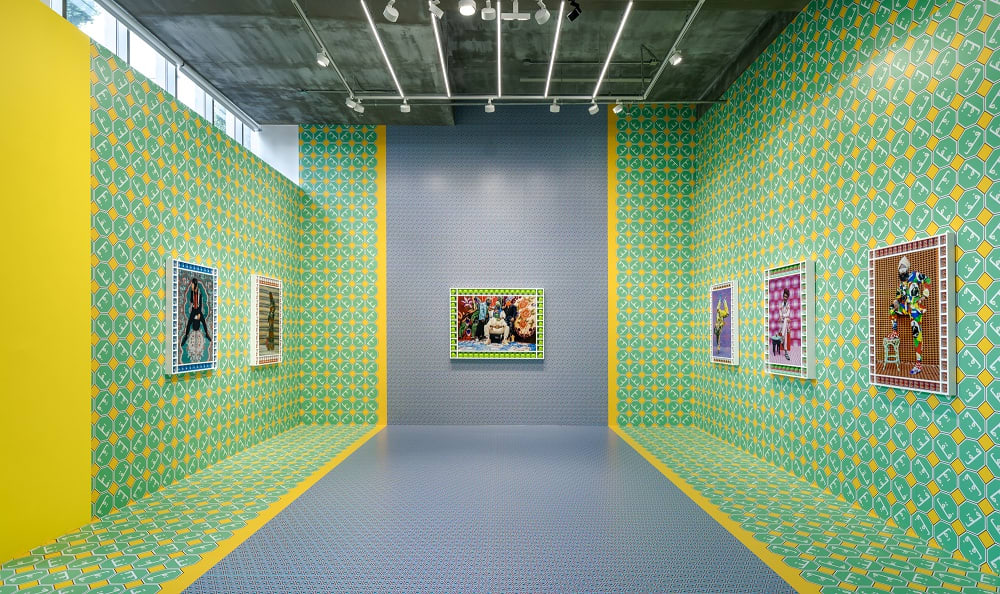
A Taste of Things to Come, 2020, Exhibition view. Courtesy of Barakat ContemporaryHajjaj’s work reflects the powerful, rhythmic colors, patterns, and unique poses of North Africa. The artist reveals the hybridity of contemporary culture by creating unique frames that incorporate bottles, cans, toys, recycled tires, and matchboxes. This is not merely decorative, but a reinterpretation of Morocco’s traditional mosaic patterns and tiles from Hajjaj’s point of view, revealing the complexities of contemporary culture. Hajjaj’s body of work is the result of his experiences in multicultural fields of art including street music, fashion and interior design, naturally encountered while living in huge, cosmopolitan London in the 1970s and 1980s, together with North Africa’s intense visual elements. Hajjaj’s work, with its rebellious and creative spirit, will guide us to a vibrant and playful world.
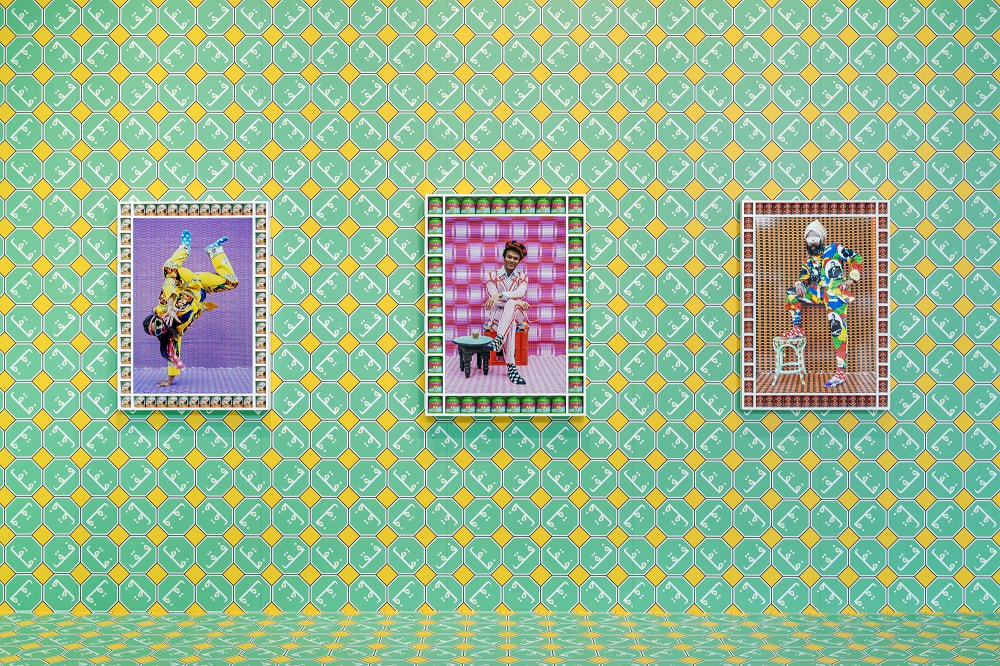
A Taste of Things to Come, 2020, Exhibition view. Courtesy of Barakat ContemporaryThis exhibition will feature a series of photographs from the artist’s representative series, including My Rockstars, Kesh Angels, Dakka Marrakchia, Legs, as well as the video work My Rockstars Experimental Vol. 2. In addition, it will be an important occasion to explore Hajjaj’s diverse fields of work, which traverse the boundaries of fashion, design, and art, at the same time as embodying his boutique space in Morocco.

A Taste of Things to Come, 2020, Exhibition view. Courtesy of Barakat ContemporaryWith their offhandedly splendid colors, patterns, and designs, Hajjaj’s images lend themselves easily to being interpreted within the category of Pop Art, but they encompass a far more complex and diverse blend of social and cultural layers. This is a pronounced quality of his portrait photographs, which boast creative framing that combines the powerful, rhythmic colors and patterns of North Africa with figures adopting idiosyncratic poses, as well as commercial objects found in Morocco including drinks, canned food, playthings, recycled tires, and matchboxes.
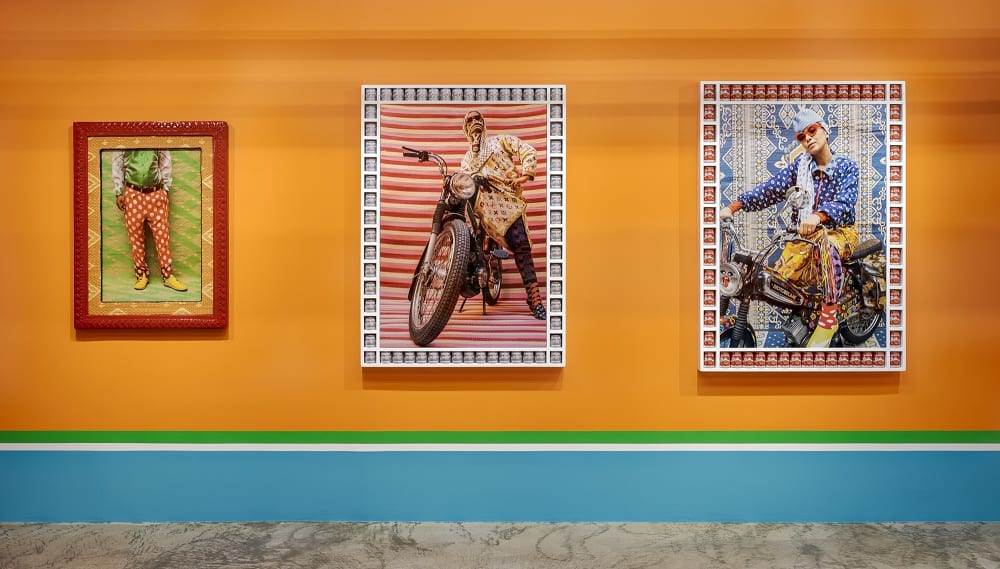
A Taste of Things to Come, 2020, Exhibition view. Courtesy of Barakat ContemporaryThe various products combined in his camera’s frame are not simply decorations; they are reinterpretations of traditional Moroccan mosaic patterns and tiles based on the artist’s own perspective, with products often chosen from those produced in the model’s country and a certain sense of humor reflected in terms of the model’s personality or profession. For example, Hajjaj’s first portraits used canned chicken to characterize female models referred to in slang as “chicks,” while cans of beef were used for “beefy” male models. The latest exhibition includes works from some of the artist’s most representative photography series—such as My Rockstars, Kesh Angels, Dakka Marrakchia, and Legs— along with the video work My Rockstars Experimental II. The My Rockstars series in particular is a record of people that Hajjaj met while operating pop-up photography studios on the streets of Marrakesh, London, Paris, and Dubai for over a decade.
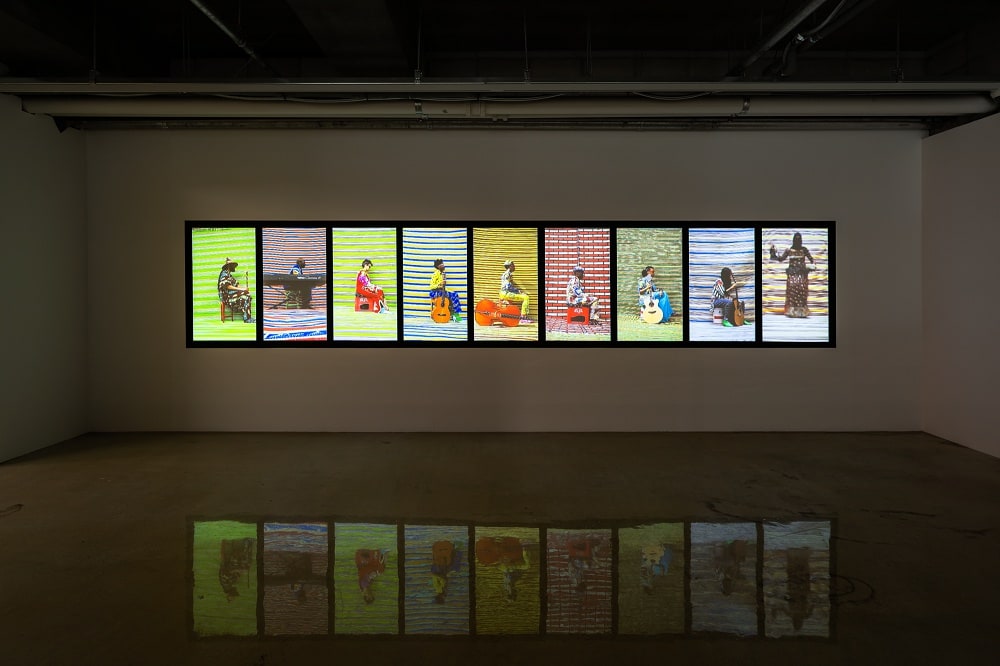
Hassan Hajjaj - My Rockstars Experimental Vol. 2, 2013; Video installation
©Hassan HajjajA diverse range of people appear in the series’ images—from famous entertainers to underground musicians, henna tattoo artists, fashion designers, hip hop dancers, martial artists, and cooks. All of them sources of artistic inspiration to Hajjaj, they each follow their own unique lifestyle and path. Within his work, new stories are created for artists working in different realms of life—from Ghetto Gastro (2018/1440), which captures a chefs’ collective working in cooking, design, and art in the Bronx, to the British fashion designer/musician/photographer in Blaize (2013/1434), the Afro-Brazilian dancer/choreographer/acrobat Rilene (2013/434), and the Malian traditional musicians in Songhoy Blues (2014/1435). My Rockstars Experimental II is a video featuring songs, dancing, and other performances by the artists in the My Rockstars photography series. A work of comprehensive art combining music, fashion, installation design, and performance, it places musicians in nine different frames as they sing, rap, play transitional instruments, and belly-dance. It offers an excellent illustration of the artist’s attempts to experiment with different media as each of the photography subjects appears in vividly moving images.
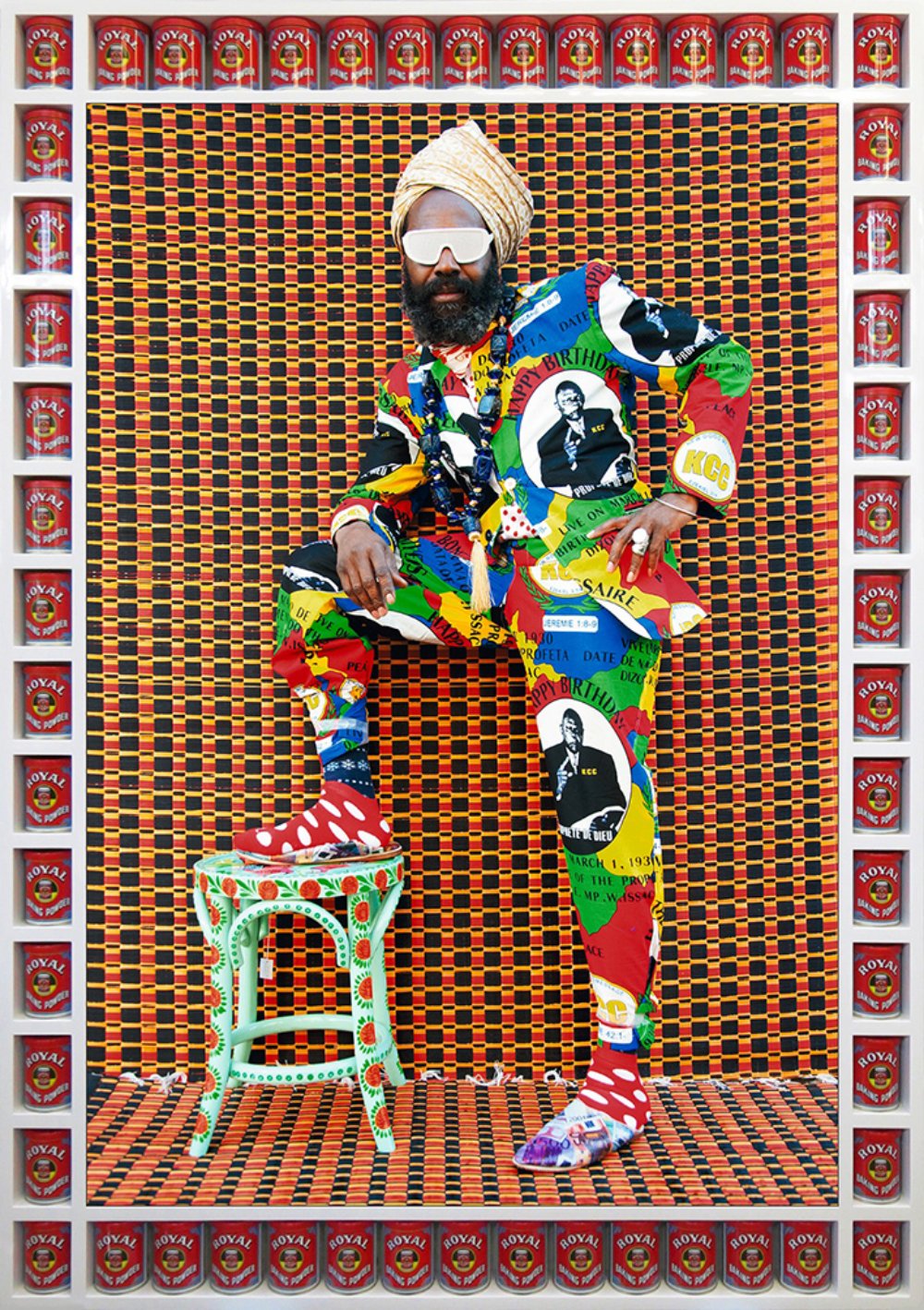
Hassan Hajjaj - Blaize, 2013; Framed photograph; ©Hassan HajjajOther leading series by Hajjaj include Kesh Angels and Dakka Marrakchia, which offer clever twists of Western clichés regarding Arab culture. Women hold an important place in these series:
the women who appear in the works wear hijabs and sit on motorbikes in Morocco’s narrow side streets. Their faces veiled in the images, they wear caftan dresses with leopard and camouflage prints. As they stand before the camera, they stare into its lens— not as secretive, passive presences, but with bold and cynical poses. Hajjaj’s camera presents its figures in bold and vibrant ways, applying the kind of shot-from-below compositions seen in fashion magazines, hip hop, and martial arts performances. The works in these series, which date back as far as the early 2000s, offer an excellent illustration of how deeply engaged the artist is with culture and gender issues.

Hassan Hajjaj - Che Lovelace, 2012; Framed photograph, ©Hassan HajjajUsing the space of photography, Hajjaj deconstructs the concept of “country” to create an utterly new dimension of the world—one where boundaries of nations, borders, peoples, and cultures have been torn down, with subjects pursuing an endless affection and joy toward life. As a second-generation immigrant who lived through an era of post-colonialism, Hajjaj focuses less on representing the historical hardships of being situated between North African identity and British colonial history than on adopting this as a new societal phenomenon, sublimating his own multicultural identity and hybridity through art. The photographic spaces he captures may be seen as similar to the “in-between spaces” described by the Indian-English philosopher and cultural critic Homi Bhabha as being linked to the conditions for understanding cultural hybridity. These are spaces where one can elude the mere homogenization or imposition of cultural meaning through colonization, focusing instead on the ambivalence of different cultures and the new cultural phenomena and meanings that emerge there.
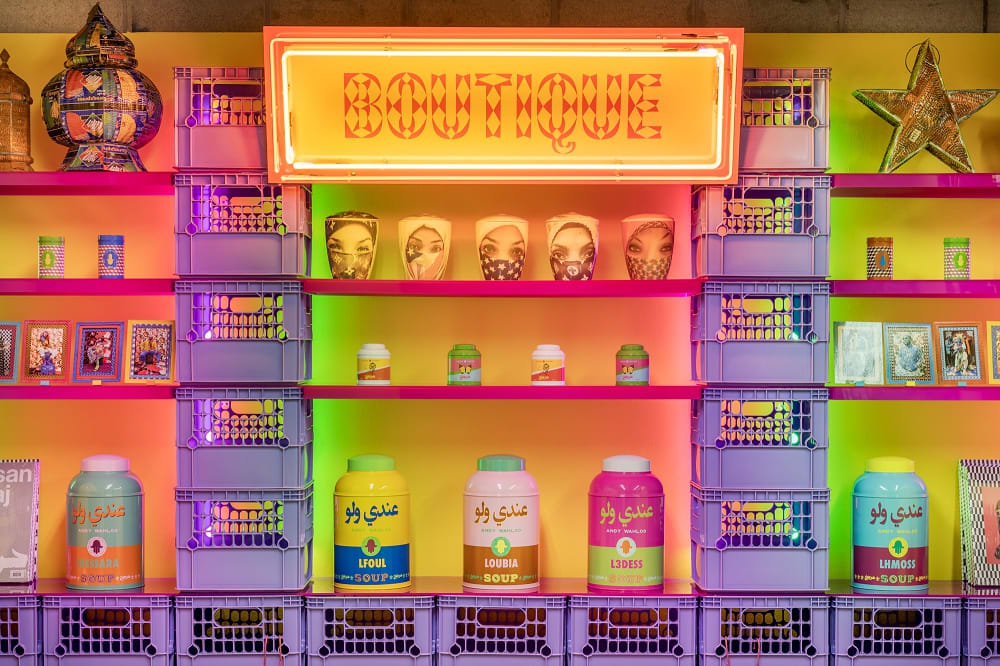
A Taste of Things to Come, 2020, Exhibition view. Courtesy of Barakat ContemporaryIn addition to his photography and video work, Hajjaj has also produced sculptures and installations. In his travels to Morocco, the artist has obsessively collected everyday items there that remind him of his childhood: book and album covers, film posters, matches, bars of soap, cans, and so forth. To create his sculptures, he had scanned or photographed these collected items to reproduce them via digital means or as newly constructed art objects. It was from this process that his early Pop Art series Graffix from the Souk emerged. Here we see the recycling of old objects that has been a major approach in Hajjaj’s art. Recycling in daily life—making mugs out of cans or using drink crates as chairs—has been a commonplace practice in Morocco, offering an excellent illustration of its socioeconomic context. Hajjaj has adopted the characteristics of this practice in his own artistic process.

Hassan Hajjaj - Ghetto Gastro, 2018; Framed photograph - ©Hassan HajjajThe works in his Graffix from the Souk series have been produced in collaboration with Moroccan artisans, craftswomen, and African refugees. As they imbue new hope and purpose into the lives of members of the community, women, and refugees, they broaden the role of art into the social realm. To help in understanding the broad-ranging nature of Hajjaj’s body of work, the latest exhibition includes a recreation of his boutique, where visitors can view Buy Me Shelf (1997/1418)—a piece derived from Graffix from the Souk—as well as various items the artist created through the recycling of Moroccan products. The boutiques that Hajjaj operates in Morocco and the UK function as artistic settings where people can actively communicate with local artists.
Hassan Hajjaj (b. 1961) was born in the northern Moroccan city of Larache and works and lives in Morocco and England. Hajjaj’s numerous solo and group exhibitions include those at the Hayward Gallery, London, Maison Européenne de la Photographie, Paris, Somerset House, London, Los Angeles County Museum of Art (LACMA), the British Museum, London, the de Young Museum, San Francisco, Centre Pompidou, Paris, and National Museum of the 21st Century (MAXXI), Rome. His work has been collected by a number of leading institutions, including the Los Angeles County Museum of Art, Victoria and Albert Museum, Guggenheim Museum Abu Dhabi, Brooklyn Museum, and the British Museum.

